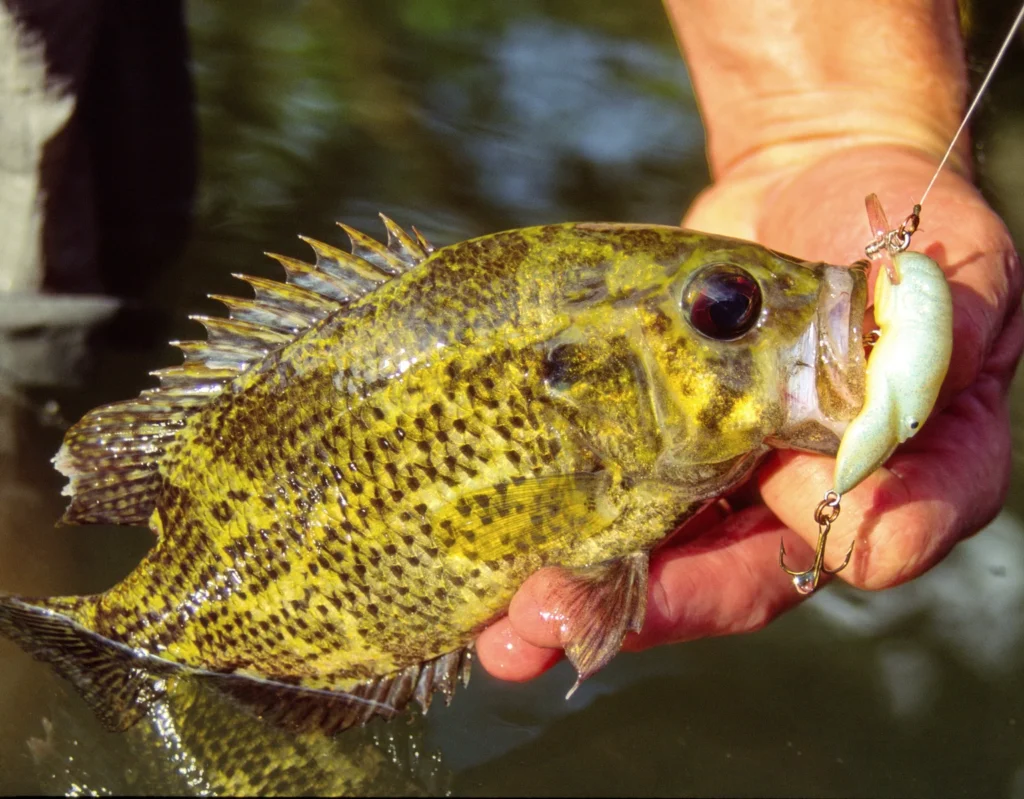

We had hoped to catch a mess of bream while fishing on the lake. But despite enjoying the beauty of the fall colors and the coolness of the autumn air, my friend Jim and I hadn’t had a nibble all morning. The lake had started its seasonal “turnover,” a process where cooler surface water mixes with warmer layers below, causing fish to scatter. To improve our situation, we decided a change of plans was in order.
We put our johnboat on a trailer and drove a few miles to a tributary that flowed into the reservoir we’d fished that morning. The lake’s flat, calm water was replaced with current and whitewater, and within minutes of beginning our float trip, our fishing luck changed as well.
Jim had impaled a live cricket on a hook and cast the bait upstream. I watched as his float slipped past a rocky ledge and was pleased when I saw it shoot out of sight. Jim set the hook with an upward snap of the wrist and seconds later swung a nice bluegill over the transom.
I tied on a Rebel Wee Crawfish crankbait, a small fishing lure that closely resembles its namesake, knowing it was an irresistible enticement for the rock bass that also called the river home. And, to my delight, after just three retrieves, I found a school of these feisty panfish actively feeding around a big boulder. I caught five in just a few minutes, and during the same interval, Jim landed another bluegill, a big green sunfish and four colorful longears.
A slow start on the lake quickly turned into fast action on the stream. Within minutes, we were catching fish at an incredible pace.
That sudden success in the stream wasn’t just luck, either. It was the result of knowing where to find fish when temperatures start to drop. Here’s why stream fishing is such a reliable option in autumn, and how you can make the most of it.
Small Works Best
The word “stream” can describe practically any body of flowing water, from a tiny creek to a river the size of the Mississippi. Here, we’ll confine our discussion to small flowages—streams small enough you’d have no trouble tossing a pebble from one side to the other. In Arkansas, some of the waters that fit that criterion include portions of the Buffalo River, Fourche de la Fave, Bayou de View, Cadron Creek, Illinois Bayou, Lee Creek and the Saline River.
One beauty of these little gems is their usually convenient locations. Small streams are found throughout Arkansas, sometimes several to the mile, and each may be home to several species of bream (the local name for a group of small sunfish family members), including rock bass, bluegills, longears, green sunfish, spotted sunfish and others. All these waters have something special to offer the adventurous angler.

Fish Like a Hunter
Fishing for small-stream bream is like hunting with a rod. Many creatures would eagerly devour these fish, so they are a nervous and wary lot, ready to streak for cover at the slightest intrusion. The silhouette of an angler standing upright will put them under rocks, brush piles and cut banks in short order, so like a hunter, you must slip up on the prey unannounced and do your work with extreme stealth.
Any decent cover in a foot or more of water is a potential bream hideout. Cast upstream or quartering upstream to fallen trees, boulders, brushpiles and ledges adjacent deep water; along the edges of coontail, willow shoots and other vegetation; under overhangs, root wads and logs along the banks; and any place where the water drops into a pool or run. The best of these spots will be in or near long, deep pools, so when you encounter a big hole or long stretch of deeper water, work it methodically. Drop successive casts about a foot apart, covering a variety of depths until fish are found.
One technique that elicits smashing strikes is to cast up on the rocks or the bank and jump the bait or lure into the water. Sunfish get a bit crazy when a popping bug or cricket behaves in this manner, or when a tiny spinner leaps from the bank and starts swimming away.
Enticements
Any bait or lure you use elsewhere will work here as well, but the best bait might be right under your feet. Tiny crayfish, nymphs, scuds, leeches and insect larvae can often be collected by carefully rolling over rocks in the stream. Worms get lots of attention during or after a rain and can sometimes be found by kicking through leaf litter along the shore. Impaled on a small hook and drifted through a deep hole, any of these baits can entice a hefty bluegill or other sunfish when your pet artificials aren’t paying off.
Tactical Tips
Whether you’re wading or floating down the stream, keep these tips in mind for a successful day of fishing:
Though you can fish most small streams by wading or walking the banks, a canoe or other boat can be much more productive than going afoot. You’ll cover more territory and be able to fish locations inaccessible by wading. Belly boats, or float tubes, are useful for covering short stretches. And for a special taste of bream fishing fun, try an overnight campout/fishing expedition when the trees are ablaze with the reds and golds of autumn. Pan-fried bream never smell or taste better than they do when cooked over a streamside fire.
At the end of the day, the best part of stream fishing isn’t just the catch—it’s the shared experience. Whether you’re reeling in bream or just watching the leaves fall, the memories made with family and friends are what make these trips unforgettable.
P.S. You can use this link to share this post: https://downhomearkansas.net/stream-fishing-for-autumn-bream.

Keith “Catfish” Sutton of Alexander, Arkansas, is one of the country’s best-known outdoor
journalists. His stories and photographs about fishing, hunting, wildlife and conservation have
been read by millions in hundreds of books, magazines, newspapers and websites. He and his
wife Theresa own C&C Outdoor Productions Inc., an Arkansas-based writing, photography,
lecturing and editorial service.




Get DownHome Arkansas blog posts, news, and more directly by email. Give us your name and email if you’d like to subscribe.